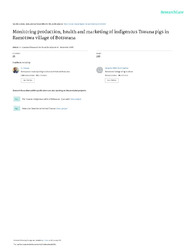| dc.contributor.author | Nsoso, Shalaulani James | |
| dc.contributor.author | Mannathoko, G.G. | |
| dc.contributor.author | Modise, Keipeile Gracious | |
| dc.date.accessioned | 2021-03-19T09:07:33Z | |
| dc.date.available | 2021-03-19T09:07:33Z | |
| dc.date.issued | 2006 | |
| dc.identifier.citation | Nsoso, S. J., Mannathoko, G. G., & Modise, K. (2006). Monitoring production, health and marketing of indigenous Tswana pigs in Ramotswa village of Botswana. Livestock Research for Rural Development, 18(9), 125. | en_US |
| dc.identifier.issn | 0121-3784 | |
| dc.identifier.uri | http://moodle.buan.ac.bw:80/handle/123456789/23 | |
| dc.description.abstract | The purpose of this study was to monitor the production, health and marketing of indigenous Tswana pigs in Ramotswa village of Botswana over a 12-month period. Farmers who rear indigenous Tswana pigs were identified by conducting a random survey throughout the village. These farmers were then interviewed using a formal questionnaire. Information was collected on demographic parameters, management system, herd composition, reproduction parameters, shelter, marketing, monthly stock movements and incidences of external and internal parasites from December 2004 to December 2005 except during April and May 2005. The data was analysed using Frequency and General Linear Model Procedures in Statistical Analysis System. Eight (8) farmers were identified, who kept a total of 67 pigs comprised of 38.8, 22.4, 19.4, 17.9 and 1.5% piglets, gilts, sows, castrates and boars, respectively. It was found that elderly females (75%) in male-headed households (62.5%) with either primary or no education (75%) farmed pigs in Ramotswa village. All the pigs used in the study were managed extensively. The majority of the farmers (75%) did not control the reproduction of their stock but the pigs were able to farrow and raise their piglets with very little assistance. All farmers did not keep any form of records. The pigs were mostly scavengers supplemented with mainly brewers grains. They were provided with shelter made from locally available materials to protect them from inclement weather and predators. Half of the farmers (50%) did not clean the shelters, but those that did clean did so by removing manure with shovels without sanitation. The pigs were mainly marketed for their meat to the local community and Chinese expatriates. During the study, 68 animals were slaughtered, while 70 births were recorded, 9 pigs were either killed by cars or stray dogs and 2 were given away as gifts. External parasites identified were Rhipicephalas evertsi evertsi and Amblyomma hebraeum ticks and Haematopinus suis lice and Ascaris suum and Trichuris suis internal parasites. Generally, the level of infestation of both external and internal parasites did not differ significantly (p > 0.05) between farms and months throughout the study period. There were no incidences of diseases reported throughout the study period. Farmers should be encouraged to improve management, husbandry practices and productivity of Tswana pigs. More research should be done to improve the overall productivity of indigenous Tswana pigs in order to conserve them through utilisation. | en_US |
| dc.language.iso | en | en_US |
| dc.publisher | Fundación CIPAV | en_US |
| dc.relation.ispartofseries | Livestock Research for Rural Development;Vol. 18 (9) 2006 | |
| dc.subject | Botswana | en_US |
| dc.subject | Health | en_US |
| dc.subject | Marketing | en_US |
| dc.subject | Pigs | en_US |
| dc.subject | Production | en_US |
| dc.title | Monitoring production, health and marketing of indigenous Tswana pigs in Ramotswa village of Botswana | en_US |
| dc.type | Article | en_US |

